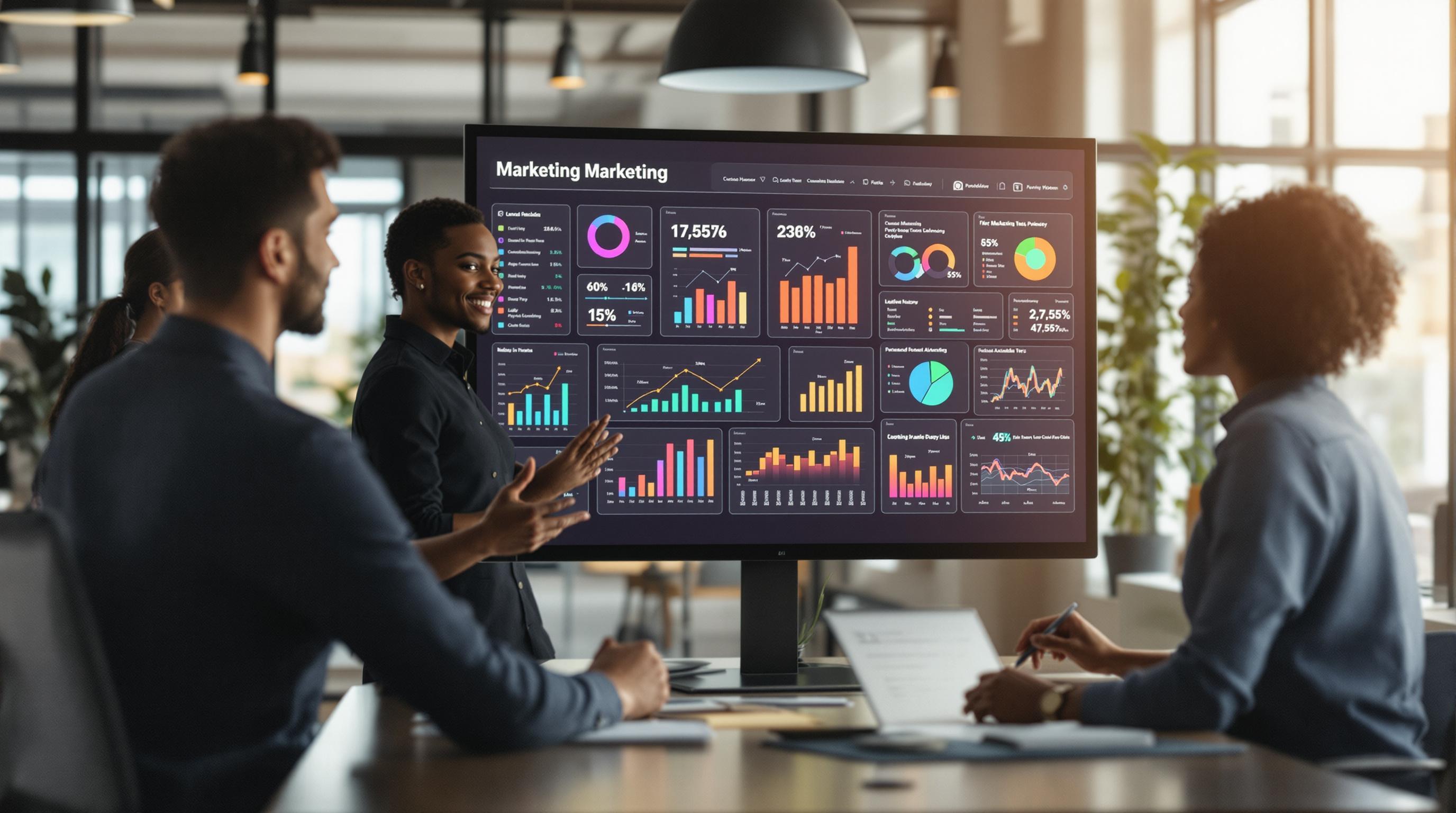Want to increase customer engagement and boost conversions? HighLevel’s AI-powered tools make it easy to create personalized client journeys by automating responses based on customer behavior. Here’s how businesses are using AI analytics and smart triggers to meet modern consumer expectations:
- Understand Client Behavior: Use metrics like engagement rates, lead scoring, and conversion drivers to identify what works.
- Set Up Triggers: Automate actions based on behavior, timing, or data changes (e.g., email opens, purchase updates).
- Create Tailored Content: Segment audiences and build dynamic templates that adapt to user preferences.
- Automate Across Channels: Sync email, SMS, and social media for consistent communication.
- Measure and Optimize: Track KPIs, run A/B tests, and refine strategies for better results.
Start by analyzing customer data, set up automated workflows, and continuously improve your approach. AI-powered personalization can increase satisfaction, retention, and conversions significantly.
Related video from YouTube
Understanding AI-Driven Analytics for Client Behavior
Building on HighLevel's automation tools, analyzing multi-channel engagement patterns helps uncover useful insights into customer behavior. Here's how to turn those insights into actionable metrics using HighLevel.
1. Key Metrics in HighLevel

HighLevel's analytics dashboard highlights three main metric categories to better understand client behavior:
| Metric Category | Key Indicators | Business Impact |
|---|---|---|
| Engagement Metrics | Open rates, click-through rates, time spent | Tracks how well your content captures client interest |
| Lead Scoring | Behavioral scores, interaction frequency, conversion probability | Helps define trigger points for automated actions |
| Conversion Drivers | Form submissions, purchase patterns, callback requests | Identifies what leads to successful conversions |
These metrics pinpoint the touchpoints that drive results.
2. Setting Up Custom Dashboards
To create a useful custom dashboard in HighLevel, align it with your specific business goals. Here’s what to include for effective client behavior tracking:
- Real-time activity feeds
- Lead status updates
- Behavioral trend charts
- Campaign performance metrics tied to your funnel stages
Tailor your dashboard to prioritize the metrics that matter most to your strategy. For example, if email marketing is central to your outreach, focus on email engagement stats and autoresponder performance.
Designing Trigger Systems in HighLevel
Once you've gathered behavioral insights using HighLevel dashboards (Section 2), the next step is putting that data into action through automated responses. Trigger systems play a key role in creating personalized client journeys by responding to specific behaviors, timing, or data changes.
Types of Triggers
HighLevel provides three main types of triggers to automate client interactions:
| Trigger Type | Purpose | Common Applications |
|---|---|---|
| Behavioral | Activates based on client actions | Email opens, form submissions, website visits |
| Time-based | Scheduled to occur at specific times | Follow-up sequences, renewal reminders |
| Data-driven | Reacts to changes in client information | Updates in purchase history, demographic changes |
Each trigger type works best when carefully aligned with the client journey.
Mapping Client Touchpoints to Triggers
To boost engagement, connect triggers to key moments in the client experience. Start by identifying critical interaction points where automation can add value:
- Initial Contact: Use triggers for actions like form submissions or website visits.
- Engagement Phase: Set up triggers based on patterns such as video views or downloads.
- Decision Stage: Target high-intent actions like visits to pricing pages or demo requests, using lead scoring metrics (Section 2.1).
- Post-Purchase: Automate triggers for onboarding processes or satisfaction surveys.
HighLevel's built-in integrations make it easy to connect these triggers across communication channels.
Best Practices for Trigger Sensitivity
To avoid overwhelming clients with too many messages, adjust trigger settings carefully. Here are some tips:
- Use Conditional Logic: Combine multiple engagement signals (e.g., three email opens plus a pricing page visit) before initiating sales outreach.
- Limit Frequency: Control how often triggers activate for each client, and use AI tools to analyze response patterns for better timing.
sbb-itb-f031672
Creating Personalized Content Journeys
Once triggers are set, the next step is crafting content that turns automated responses into meaningful interactions. HighLevel offers tools to create dynamic content journeys that adapt to user behavior in real time.
Audience Segmentation
Effective segmentation is the backbone of personalized content. HighLevel's filtering system helps you create precise audience groups using three main dimensions:
| Segmentation Type | Data Points | How It’s Used |
|---|---|---|
| Behavioral | Website visits, email engagement, purchase history | Targets based on actual user actions |
| Demographic | Age, location, industry, company size | Tailors messaging to specific profiles |
| Preference-based | Content interests, communication preferences, product needs | Sends relevant offers and updates |
These segments guide the creation of dynamic templates, which we’ll explore next.
Building Content Templates
HighLevel's drag-and-drop editor makes it easy to design reusable content templates. Aim to create templates that cater to different audience needs while staying true to your brand.
Key elements for these templates include:
- Dynamic headers: Personalized titles to grab attention.
- Industry-specific sections: Flexible blocks that can be swapped based on the audience.
- Adaptable CTAs: Calls-to-action that adjust based on user engagement levels.
Using HighLevel's Personalization Features
HighLevel’s personalization tokens and conditional content allow you to create highly tailored communications.
Here’s how to make the most of these features:
Dynamic Personalization Rules
- Add tokens for details like company name, recent interactions, and product interests.
- Highlight enterprise features for larger companies.
- Include industry-specific case studies tailored to the client’s sector.
- Adjust pricing details based on geographic location.
Dynamic Content Timing
Use HighLevel's AI-powered analytics to send messages at the best times for user engagement. This timing feature works hand-in-hand with the trigger sensitivity controls discussed earlier, ensuring your content reaches users when they’re most likely to respond.
Implementing Multi-Channel Automation
With personalized content templates already established (see Section 4), HighLevel allows you to expand these efforts across various channels using three main automation tools:
Integrating Multiple Channels
HighLevel's platform ensures seamless coordination across different communication channels:
| Channel Type | Primary Use | Execution Strategy |
|---|---|---|
| Detailed information, newsletters | Leverage AI to optimize timing and sync with website-triggered behaviors | |
| SMS | Time-sensitive updates, reminders | Apply AI engagement insights to schedule delivery and set limits on message frequency |
| Social Media | Brand awareness, community engagement | Plan posts around AI-identified peak engagement times and align with email/SMS efforts |
The key is maintaining brand consistency while tailoring messages to suit each channel's unique format.
Adding Conditional Logic to Workflows
HighLevel’s workflow builder makes it easy to design workflows that adapt to client behavior.
Key Decision Points Include:
- Preferred communication channel (based on past engagement history)
- Optimal timing for sending messages
- Best-suited content format (text, images, or video)
- Follow-up frequency determined by engagement levels
Testing and Optimizing Automation
To keep improving, regular testing and adjustments are essential. HighLevel’s analytics dashboard offers real-time data on workflow performance.
Steps for Optimization:
- Compare metrics for each channel against the KPIs outlined in Section 2.1.
- Fine-tune triggers using sensitivity controls from Section 3.3.
- Update audience segments using behavioral filters from Section 4.1.
Additionally, use lead scoring thresholds (see Section 2.1) to identify high-value accounts that may benefit from personal follow-ups.
These refinements directly feed into the performance measurement strategies outlined in Section 6.
Measuring and Refining Personalized Strategies
Using HighLevel's automation workflows (Section 5) as a foundation, tracking the right metrics ensures your personalization efforts stay aligned with your business objectives.
Key Performance Indicators
| Metric Category | Key Targets |
|---|---|
| Engagement | 15-25% CTR/open rate boost |
| Conversion | 20-30% rise in form submissions |
| Retention | 40% higher retention compared to baseline |
| ROI | 25% reduction in acquisition costs |
Custom dashboards make it easy to monitor these metrics in real time. This way, you can quickly adjust strategies if performance starts to lag.
A/B Testing in HighLevel
A/B testing is crucial for refining personalization efforts. HighLevel's tools let you test and optimize with data-driven precision.
1. Test Structure Setup
Run controlled experiments by tweaking one variable at a time. Prioritize elements that can make the most impact, such as:
- Email subject lines with different personalization tokens
- SMS timing based on past engagement
- Landing page content using dynamic fields
- Placement and messaging of call-to-action buttons
2. Data Collection Period
Allow at least 14 days of testing with a minimum of 1,000 interactions per variant to gather meaningful insights.
3. Analysis and Implementation
Roll out the best-performing versions across campaigns. HighLevel's analytics dashboard helps you track and measure improvements over time.
These test outcomes feed directly into the iterative improvement strategies outlined below.
Iterative Strategy Improvement
Use insights from testing to refine your approach through structured review cycles.
Monthly Review Protocol
- Examine trends across all active campaigns.
- Highlight top-performing personalization techniques using lead scoring metrics from Section 2.1.
- Log unsuccessful strategies to avoid repeating mistakes.
- Update audience segments based on fresh behavioral data.
Quarterly Strategy Updates
- Adjust personalization rules based on collected data.
- Fine-tune trigger sensitivity thresholds.
- Refresh content templates with messaging that has proven effective.
- Improve multi-channel coordination for better results.
Research indicates that 80% of consumers are more likely to purchase when brands deliver personalized experiences [1]. This underscores the importance of continually testing and fine-tuning your trigger-based personalization strategies (Section 3).
Conclusion: The Impact of Personalized Client Journeys
Key Takeaways
Using the workflows and testing frameworks discussed earlier, HighLevel's AI-driven triggers have shown to increase customer satisfaction by 20-30% and boost conversions by 15-20% through predictive personalization [2].
These predictive triggers leverage real-time data to create meaningful, context-based interactions. This approach consistently improves engagement, conversion rates, and customer retention.
Next Steps for Implementation
To start enhancing your client relationships with AI-powered personalization:
1. Establish a Strong Data Foundation
Set up the custom dashboards described in Section 2.2 to track key metrics aligned with your business goals. Focus on collecting behavioral data to power your personalization efforts.
2. Develop Automated Triggers
Begin with the trigger systems outlined in Section 3, starting with simple behavioral responses. Use the KPIs from earlier sections to monitor and evaluate their effectiveness.
3. Refine Through Regular Reviews
Follow the monthly review process discussed earlier to fine-tune your personalization strategies. Consistently applying these steps will help build stronger, long-term client relationships.
Personalization is an ongoing process. Use the frameworks in this guide as your starting point, measure your results carefully, and adapt your strategies based on what works best for your audience.
Related Blog Posts
- Integrating AI Tools with HighLevel: A Blueprint for Next-Gen Agency Automation
- Advanced Automations: Merging AI Chatbots and HighLevel for Seamless Client Support
- Data-Driven Marketing: Using HighLevel and AI Insights to Refine Your Campaigns
- Workflow Optimization: Uniting AI Automation and HighLevel’s Pipeline Features



